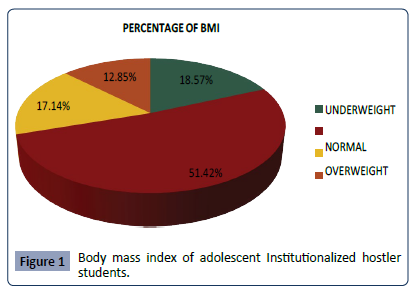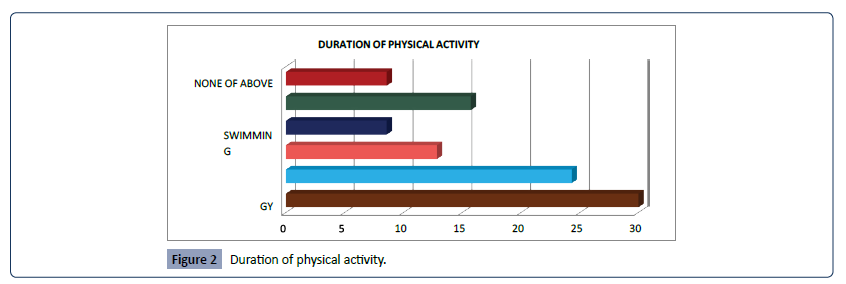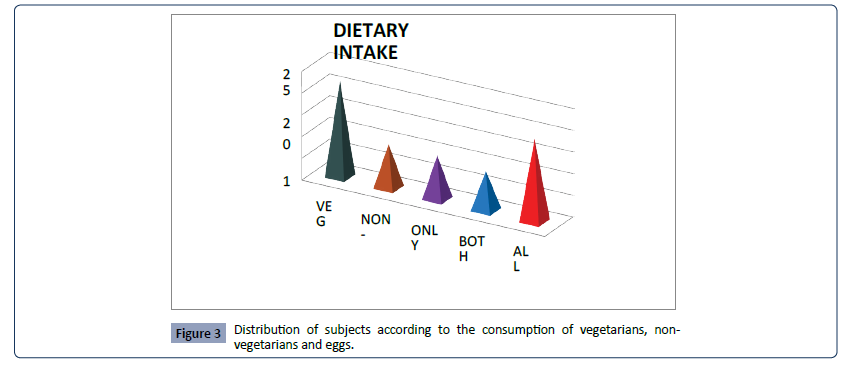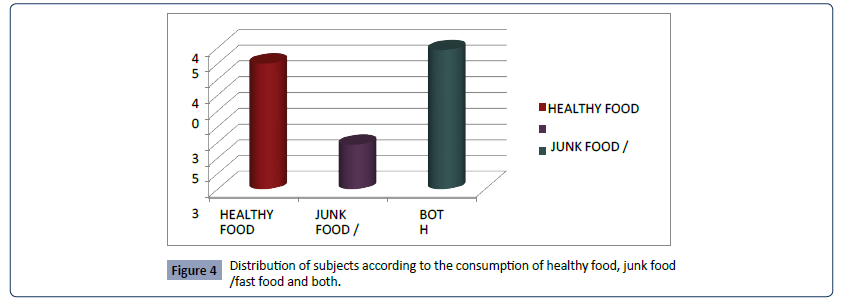Abstract
The study to assess the nutritional status of adolescent students was conducted at the Institutionalized hostels of Chandra Shekhar Azad University, Kanpur, and Uttar Pradesh, India. In this study 70 members of adolescent Institutionalized hostellers students were selected and they were assessed for the nutritional status. The nutritional status was assessed with the help of their dietary intake using 24 hours recall method, anthropometry measurement, dietary assessment, along with nutritional knowledge (set of 70 questions to assess nutritional knowledge relating to balanced nutrition and health status). Students' general health status can be impacted by their dietary habits and lifestyle choices. According to the report which details the nutritional status of the hostler girls institutionalized as adolescents, 51.44% of the girls had a normal BMI, 18.57% were underweight, 17.14% were overweight, and 12.85% were obese and adolescent girls' food intake is 103.6% appropriate nutrition practices. This study identifies the pattern of food consumption among adolescents. Girls are better than in the proportion of consuming nutrients like Protein, Carbohydrates, Minerals, Vitamins, and Fats, dietary supplements in breakfast, and lunch habits. Displays data about participant’s daily routines. Participant’s physical activity was broken down into yoga, running/walking, dancing, gym, swimming, and any other activities. Girls performed yoga at a rate of 30%, while boys performed running/walking at a rate of 24.28%, while girls danced at a rate of 12.85%, and men participated in the gym at a rate of 8.57%. Adolescent girls did not participate in any of the other 8.57 physical activities.
Keywords
Nutrition Status; Adolescent; BMI; Anthropometry; Obese; Dietary
Assessment; Knowledge; Physical Activity
Introduction
The purpose of this study was to investigate how adolescents'
eating habits and nutritional status relate to one another. As a
result, increasing adolescent understanding of the value of good
nutrition during the growth phase and understanding related to a
healthy diet requires the collaboration of numerous parties. It is
intended that more research will be done on additional elements
that affect adolescents' nutritional condition. Expanding
knowledge has a significant impact on how people live [1-3]. India
is a developing nation whose way of life is changing significantly,
especially with regard to how university students commute.
Adolescents are becoming less physically active and are sitting
down more often. Adolescents continue to be susceptible to
issues with under- and overeating. The food served at their
hostel should satisfy all of their daily nutritional needs because
certain foods are served in insufficient quantities or with a poor nutritional composition by the hostels.
University students are responsible and aware of the value of
correct nutrition, but they frequently disregard healthy eating and
diet. Girls who live in dorms typically eat from canteens where the
food is prepared in an unclean manner, most of the vital nutrients
are typically destroyed, and the food does not meet the students'
nutritional needs. As it is common knowledge that students living
in dorms can be classified as adolescents, extra eating time is
necessary to meet the body's demands for growth. As a result of
their increased food intake from academics and other university
activities, students need to consume more nutrients. But due to
the socioeconomic issues that are now plaguing underdeveloped
nations, such as Kanpur, it is well known that students receive
subpar nutrition because few people can afford to buy healthy
food. As a result of inadequate food procedures, students living in
hostels consume few nutrients [4].
Adolescents frequently experience nutritional issues. The double
burden of malnutrition refers to this issue with adolescent’s health.
Many adolescents suffer from under nutrition and over nutrition,
a condition known as the "double weight of malnutrition." Many
nations, particularly low- and middle-income nations, experience
this double weight. Malnutrition in Adolescents are an issue that
is becoming more widespread [5].
Since habits formed during this period frequently last throughout
the adolescent years, it is a vital time for promoting healthy
eating and lifestyle choices. Food intake is influenced by a
variety of factors, including as eating habits, snacking habits,
nutritional understanding, and family economics (parents'
jobs, the availability of food, living conditions, and parental
income). Environment, agent, and host are indirect contributors.
Nutritional requirements, metabolism, and physiology are
examples of host factors. Agent factors include nutrients,
including macronutrients like proteins, lipids, and carbs as well
as micronutrients like vitamins and minerals. Ingredients in food,
how it is processed, serving size, personal hygiene, and sanitation
are all environmental influences [6].
Different anthropometric parameters, particularly weight and
height, represent the physical development of adolescent girls.
When a person is developing and in the college years, nutrition
has a significant impact on the physical dimensions of the
body. Both job capacity and cognitive abilities will be impacted
by poor health and nutritional state. As children go through
physical, mental, emotional, and social changes, this age group
is a dynamic time of growth and development. Therefore, it is
important to evaluate this demographic group's nutritional
health. The adolescent girls who eat breakfast will eat fewer
calories throughout the rest of the day. Skipping breakfast makes
your body goes into starvation mode, leading you to compensate
and overeat later in the day 1. In addition, it’s not only eating a
breakfast but eating a healthy well-balanced meal [7].
It is important to have a breakfast that consists of protein, grains
(such as whole grain breads or cereals) and fruits. A combination
of these types of foods helps to keep your energy level up
throughout the day. Girls often skip breakfast in an attempt to
manage their weight. By skipping breakfast, it can often lead to
more snacking later on in the day, increasing food intake. Food
and how it is consumed, digested, and assimilated are always
a part of nutrition in order to supply our bodies with the right
nutrients and protect them from various illnesses and infections.
A physically and emotionally healthy atmosphere is encouraged
through nutrition. In order to have a healthy life in society, one
needs to eat properly [8-12].
Additionally, biochemical analysis, clinical observation, evaluation
of fat and lean body mass, and other methods can be used to
establish nutritional status. Additionally, measuring each
person's height and weight and determining their Body Mass Index
(BMI) is the coolest and most straightforward way to determine
the nutritional state of a community. The definition of kilograms
per square meter is kilograms divided by height in meters (kg/
m2). Malnutrition is a category for nutritional status that includes
both under nutrition and overnutrition.The components of diverse foods called nutrients are what fuel biological activity and
are vital to our bodies. The body may become malnourished if the
daily nutritional supplements required of dormitory girl students
are not met. It may result in physiological system alterations,
metabolic changes, and changes in body mass [13, 14].
One of the main factors contributing to nutrition-related health
issues in individuals, particularly in adolescent girls who are away
from home, especially in hostel girls, is inadequate food intake
and poor eating habits (junk foods) at inappropriate and irregular
schedules. The study's objective was to determine how often
female university students were overweight or obese. According
to their typical eating routines and body composition. Thus,
including food in the diet reduces energy intake, aiding in weight
management. We are aware that students who lived in dorms
might need extra support for their academic performance to
participate in extracurricular activities on campus. The food served
in their dorms should satisfy their daily nutritional needs. Due to
the inadequate nutritional makeup of some institutions' cuisine.
The major objective of this study is to examine dormitory girls'
knowledge, attitudes, and practices regarding their nutritional
needs. The factors both directly and indirectly affecting dietary
status [15-18].
Materials and Methods
Selection of Hostels
The present study was conducted at Institutionalized hostels of
Chandra Shekhar Azad University Kanpur, Uttar Pradesh, India. A
total of 70 adolescent girls’ hostels students were selected for
the study. A random selection method was used to select the
students.
Survey development and data collection
The pre-prepared questionnaire was developed to gather
information on 70 girls of adolescent the students were selected
for the study anthropometric measurements of nutrient intake
and physical activity they were assessed for the nutritional status.
Background information
The study was carried out from March, 2022 to March, 2023.
Anthropometric measurements
Nutritional status is the condition of health of an individual
as influenced by the utilization of nutrients. Anthropometric
indices such as height, weight and body mass index (BMI) were
measured and tabulated. Height of an adolescent is an important
anthropometric measurement which sums up the linearity of
the body. Weight is most useful anthropometric measurement
which relates to the body mass as its potential value is not only
appreciated by the health personnel, but often by parents from
whom it is useful source of health information. BMI also known
as Quetlet’s index. It is defined as the ratio of weight in kilograms
and height in meter square. The height and weight recorded
earlier were used to evaluate BMI of students [1].
Dietary assessment
Twenty-four-hour dietary recall method describes food and beverages in detailed that an individual consumed in the past
24 hours. The interview is conducted in two ways of "starting to
recall from the beginning of the recalling day" or "starting with
the current day and works backward" and in general requires
approximately 15 to 20 minutes by depending on the types and
variety of the food that is consumed [19-22].
Nutrient intake
Nutrient intake was calculated using ready reckoner developed
by Department of Food Science and Nutrition, of Chandrasekhar
Azad University Kanpur. Food frequency using frequency
questionnaire, clinical examination by visual assessment, health
problem by oral questionnaire and nutritional knowledge using
questionnaire (set of 70 questions to assess nutritional knowledge
relating to balanced nutrition and health status).
Physical activity
In the developing years of college age, nutrition has a significant
impact on how the body looks physically. Poor nutrition and
health will have an impact on cognitive abilities as well as work
capacity. And this age range is a period of dynamic growth and
development as adolescent females go through physical, mental,
emotional, and social changes [23, 24].
Result and Discussion
The method of anthropometry is frequently employed to evaluate
a girl's development and nutritional state. For monitoring nutritional
status, such as underweight, overweight, and obesity, height and
weight are the most helpful anthropometric measurements. As
a result, the current study intends to thoroughly examine the
knowledge, attitudes, and behaviours of hostel girls regarding
nutrition, their dietary practices, and their level of physical activity,
as well as the factors that influence their food selections (Table 1).
| S.No. |
Nutritional Status Of The Girls |
| 1 |
Body Measurement |
Total |
Percentage |
|
Underweight |
13 |
18.57% |
|
Normal |
36 |
51.44% |
|
Overweight |
12 |
17.14% |
|
Obsess |
9 |
12.85% |
| 2 |
Physical Activity |
|
Percentage |
|
Yoga |
21 |
30% |
|
Gym |
6 |
8.57% |
|
Dancing |
9 |
12.85% |
|
Swimming |
11 |
15.71% |
|
None Of Above |
6 |
8.57% |
| 3 |
Dietary Intake |
|
Percentage |
|
Healthy Food |
28 |
40% |
|
Junk Food / Fast Food |
14 |
14.28% |
|
Both |
31 |
44.28% |
|
Veg |
22 |
31.42% |
|
Non-Veg |
10 |
14.28% |
|
Only Egg |
10 |
14.28% |
|
Both |
9 |
12.85% |
|
All |
24 |
24.14% |
Table 1. Institutionalized Student Staying In Girls Hostels (N=70).
According to the report, which details the nutritional status of
the Hostler girls institutionalized as adolescents, 51.42% of the
girls had a normal BMI, 18.57% were underweight, 17.14% were
overweight, and 12.85% were obese and adolescent girls' food
intake is 103.6% appropriate nutrition practices. Info on physical
activity levels 37.1% of the hostelled girls participated in various
forms of physical activity (Figure 1).

Figure 1: Body mass index of adolescent Institutionalized hostler
students.
Different anthropometric parameters, particularly weight and
height, represent the physical development of adolescent girls. In
the growing years of college age, nutrition has a big impact on the
physical measurements of the body. According to Figure 1, which
presents the nutritional status of the adolescent institutionalized
Hostler girls, 51.42% of the girls had normal BMI, 18.57% were
underweight, 17.14% were overweight, and 12.85% were obese
(Figure 2).

Figure 2: Duration of physical activity.
Figure 2 displays data about participants' daily routines.
Participants' physical activity was broken down into yoga, running/
walking, dancing, gym, swimming, and any other activities. Girls
performed yoga at a rate of 30%, while boys performed running/
walking at a rate of 24.28%, while girls danced at a rate of 12.85%,
and men participated in the gym at a rate of 8.57%. Adolescent
girls did not participate in any of the other 8.57 physical activities
(Figure 3).

Figure 3: Distribution of subjects according to the consumption of vegetarians, nonvegetarians
and eggs.
The results of the present study will be used to suggest
modifications to the nutritional profiles of the girls by assessing
their nutritional status and level of nutrition knowledge. Your
lifestyle may be impacted by living on campus, which may alter
your eating habits. Girls' eating patterns remain constant with
their healthy eating habits throughout their collegiate careers.
Conditions that encourage irregular mealtimes, skipping meals,
and excessive snacking have a deleterious impact on university
students, especially those living in hostels. According to Figure 3,
the majority of people who had a high degree of knowledge about
their health and diet had lower dietary intakes than vegetarians
(31.42%), non-vegetarians (14.28%), and merely those who
consumed eggs (14.28%).
Health status for adolescent (Figure 4)
Adolescent girls' healthy eating habits are crucial because actions
taken now will have an impact on their girls' eating habits and overall health in the future. Therefore, the purpose of the current
study was to evaluate nutritional and food intake. According to
Figure 4, the majority of girls who had a high degree of knowledge
about their health diet had dietary intakes than healthy food
(40%), junk food / fast food (14.28%), and merely those who
consumed both (44.28%) (Table 2).
| Items |
Number of cases (%) |
| Do you know about nutrients like Protein, Carbohydrates, Minerals, Vitamins, and Fats? |
|
| Yes |
37.10% |
| Slightly |
11.90% |
| Not at all |
0% |
| Do you take any dietary supplements? |
|
| Daily |
27.30% |
| Once in a while |
12.60% |
| Never |
8.40% |
| Does your dietary pattern keep changing? |
|
| Yes |
30.80% |
| Once in a while |
4.20% |
| Never |
8.00% |
| All |
5.60% |
|
|
| Do you ever feel tiredness, bloated, dizziness and weakness after eating hostel meal? |
|
| Yes |
9.10% |
| No |
14% |
| Sometimes |
25.90% |
Table 2. Food consumption in pattern of adolescent’s girls.

Figure 4: Distribution of subjects according to the consumption of healthy food, junk food
/fast food and both.
This study identifies the pattern of food consumption among
adolescents. Table 2 shows that girls are better than in the proportion of consuming nutrients like Protein, Carbohydrates,
Minerals, Vitamins, and Fats .dietary supplements in breakfast,
and lunch habits. Daily, Once in a while, Never is 27.3% , 12.6%and
8.45. The proportion of girls who consumes dietary pattern keep
changing is Yes 30.8%, Once in a while 4.2%, Never 8.%, All 5.6%
higher than a girls which is you ever feel tiredness, bloated, dizziness and weakness after eating hostel meal .Yes 9.1%, No
14%, Sometimes 25,9.The habit of eating fast food also shows the
same [25].
Conclusion
In the developing years of college age, nutrition has a significant
impact on how the body looks physically. Poor nutrition and
health will have an impact on cognitive abilities as well as work
capacity. And this age range is a period of dynamic growth and
development as adolescent females go through physical, mental,
emotional, and social changes. Conditions that encourage
irregular mealtimes, skipping meals, and excessive snacking have
a deleterious impact on university students, especially those
living in hostels. The results of the present study will be used to
suggest modifications to the nutritional profiles of the girls by
assessing their nutritional status and level of nutrition knowledge.
Your lifestyle may be impacted by living on campus, which may
alter your eating habits. Which presents the nutritional status
of the adolescent institutionalized Hostler girls, 51.42% of the
girls had normal BMI, 18.57% were underweight, 17.14% were
overweight, and 12.85% were obese.
Acknowledgement
I would like to thank the Faculty of Food and Nutrition, Babasaheb
Bhimrao Ambedkar University, Lucknow, and Professor Sunita
Mishra, Dean, Food and Nutrition, School of Home Science,
Babasaheb Bhimrao Ambedkar University for supporting and
providing all possible resources to undertake this research work.









